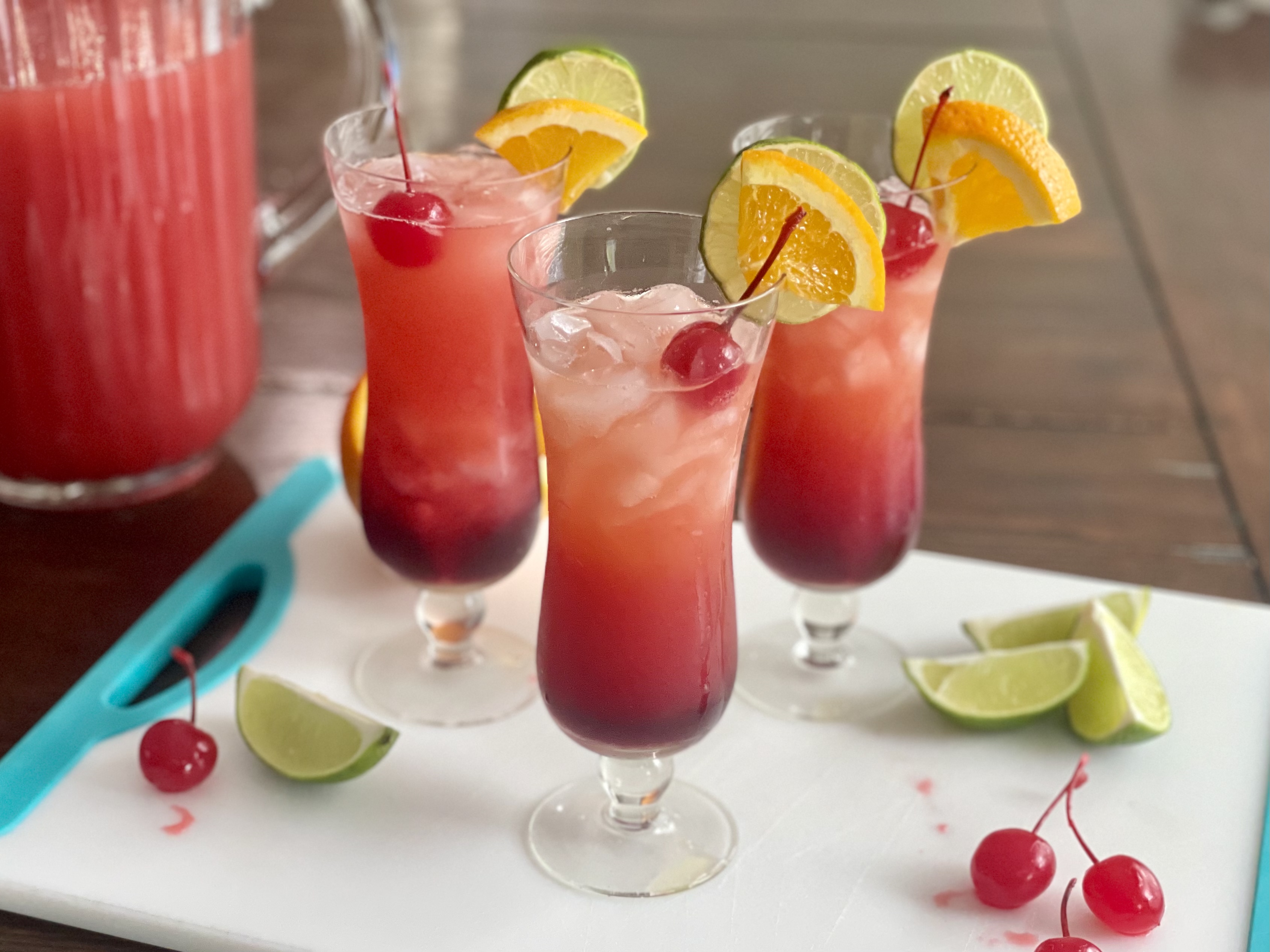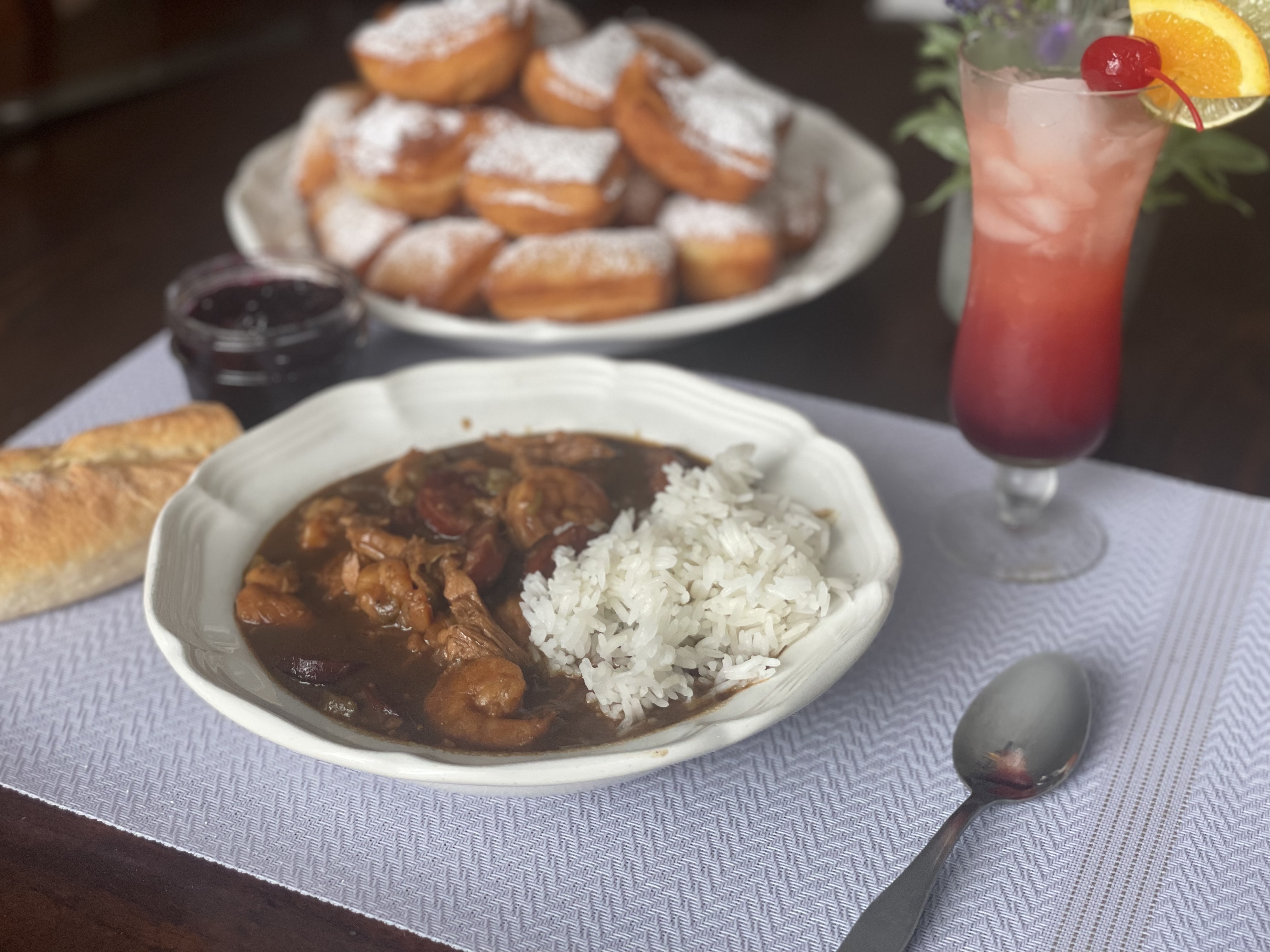Inspired by Louisiana

The cuisine of Louisiana is so unique and iconic! It was unlike anything I’d ever made before and kept me full the rest of the day!
THE MEAL
(Click on the links above to jump to that part of the post!)
This meal comes all the way from the Bayou State, home of New Orleans, Mardi Gras festivals, jazz music, and of course, Creole and Cajun food.
Louisiana culture is a beautiful blend of Native American, French, Canadian, and African influence, and its food reflects that! “Cajun” refers to the food and culture brought by French settlers who migrated from the eastern coast of Canada (a region called Acadia) down south to what is now the French Quarter of New Orleans. “Creole” was used to describe people born to immigrant settlers in colonized Louisiana, basically first-generation Louisianans of all races. Cajun and Creole history is tangled and complicated, but the main difference between the two food-wise is that Creole cuisine generally includes tomatoes and is considered “city food” while Cajun is “country food.”
If you’ve paid attention to the news lately, you probably know that Louisiana is currently suffering from the effects of Hurricane Ida back in August. Some areas outside of New Orleans still don’t have power, and many people have been displaced from the power outages and damage to their homes done by the storm. If you would like to help, here’s a link to a number of organizations you can donate to.
I almost put off doing a Louisiana-inspired meal in the wake of the hurricane, but I also wanted to bring attention to it in some small way, even if it’s just me learning more about the people there and appreciating their culture through this meal.
With that said, making this meal was an awesome experience. I tried so many new things and my taste buds sure learned a lot!

GUMBO
The main part of this meal was Louisiana’s iconic state cuisine, gumbo! Gumbo is a stew with a very flavorful broth and a mix of seafood, veggies, and sausage. It’s a cuisine born of Louisiana’s melting pot of cultures, and its name comes either from an African word for okra or a Choctaw word for sassafrass, both key ingredients in gumbo.
There are SO MANY ways to make this dish, and I was intimidated at first by the long list of ingredients. But making it, while a little tricky, wasn’t as difficult as I expected it to be.
The most unique aspect of making gumbo is starting off by making a dark roux. You’ve probably made a roux before–just a mix of flour and fat to thicken whatever sauce or broth you’re making–but instead of just mixing flour and fat together, gumbo calls for you to cook the roux over medium heat until it goes from cream-colored to gold to dark chocolate brown. To do it right, you have to stir CONSTANTLY and not walk away or else it WILL burn, and the process can take anywhere from 20 minutes to a full hour! Thankfully mine only took about 20 minutes, but it was an arm workout for sure!
After getting the roux nice and dark, you add the “Cajun Holy Trinity”–diced green pepper, celery, and onion. From there, it’s just a matter of adding stock and veggies and meats and a LOT of spices. For mine, I included chicken, sausage, and shrimp. Adding okra and/or file powder (ground sassafras) thickens it up, and letting it all simmer together for several hours creates a distinctly Southern blend of flavors and textures.
I liked it! It was very different from anything I’d ever had before, and I wasn’t sure at first if it was my thing. It was a little too much for my family. My dad and brother-in-law gamely ate a bowl each, but my mom could only handle a few bites before calling it quits. But I’ve been eating the leftovers for the past couple of days, and it’s grown on me! They do say that it only gets better the longer it sits–some even recommend cooking it the day before serving so the flavors can really get to know each other.
Anyway, it was spicy without burning your tongue off. I can see why Southerners always say that other cuisine has no flavor; theirs has SO MUCH flavor! I found that eating it with rice and bread was a good way to tone it down a bit. Gumbo is often served with rice–Louisiana is the third-largest producer of rice in the United States. They grow mostly long-grain rice, which, incidentally, is my favorite kind! Gumbo is also commonly served with French bread, which I made from scratch for this meal.

FRENCH BREAD
French bread was brought to New Orleans by French settlers, as you probably could’ve guessed. In addition to being served with gumbo, it’s also commonly used for po’ boy sandwiches!
In the U.S., “French bread” is basically any crusty bread shaped like a baguette. It can have sweeteners, use sourdough starter, whatever! But in France, the rules about when and where people can make baguettes, and with what ingredients, are strictly regulated to maintain quality control. By law, French bread can only be made with flour, water, salt, and yeast! Despite that, there are many different methods for making French bread, but I tried to go with the most basic method using only the prescribed ingredients.
This is a great bread recipe for when you don’t have any fancy ingredients on hand! It’s time-consuming, but so is most bread. And it made much less of a mess than other breads I’ve made before!
I was worried at first that there was no way the dough would get bubbly and airy if the yeast didn’t have something sweet to feed on. I always thought that was a must! But this dough got SUPER bubbly, and the repeated folding and resting process made it airy and fluffy. The hardest part was probably the shaping. I made this bread twice. The first attempt, I learned that it’s really important to seal up any seams when shaping the baguette, or else they’ll explode open on you. The second attempt, I learned that you really need to use a scoring tool or really sharp knife to make the iconic French bread slashes, or else you’ll squish the dough and ruin the airiness. With both attempts, though, the bread tasted great! I just need a little extra practice with the shaping and scoring. I also could have cooked them longer. I’ve found that I love making bread in steamy ovens to make that nice crunchy crust, but I always worry about overbaking and accidentally take them out too early.
Another first with this recipe was using a baker’s couche to support the baguettes in their final proofing phase. If you’re like me and don’t have a baker’s couche on hand, I found that using a floured pillowcase worked just fine!
While my baguettes didn’t exactly turn out picture-perfect, the recipe is solid, and I know I’ll get the hang of it someday. Again, if you want to make bread but don’t have a lot of ingredients, this is a great way to go!

HURRICANE MOCKTAIL
This drink was one of those things I was worried about when making a Louisiana-inspired meal so soon after Hurricane Ida. In the United States, Louisiana is second only to Florida in hurricane frequency–according to the NOAA, one hurricane touches landfall in Louisiana about every 3 years! This cocktail is called a hurricane because it’s traditionally served in hurricane glasses–tall glasses that resemble the glass chimneys that protect the flames in hurricane lamps from the region’s strong winds.
This cocktail was said to have been invented during WWII when whiskey was scarce and local bartenders had to find uses for rum instead. Rum is really sweet, apparently, and is found in a lot of tropical cocktails. The mocktail substitute is usually pineapple juice!
This hurricane mocktail’s base is made up of passion fruit juice, orange juice, pineapple juice, and lime juice. I used pomegranate juice in place of grenadine syrup and poured that into the glasses first. When topped off with the rest of the juice, it created a pretty sunset effect.
It was a very fruity drink, as you can imagine! I liked it, but it felt like a lot of ingredients for what basically tasted like fruit punch. Honestly, though, I was just happy to have an excuse to buy a jar of maraschino cherries. I love them!

BEIGNETS WITH BLUEBERRY PRESERVES
What other dessert could I possibly make for a Louisiana-inspired meal except beignets??
Also French in origin, beignets (pronounced “BEN-yays”) are Louisiana’s official state donut. Traditionally square in shape and coated with powdered sugar, these fried pastries are simple but delicious. They’ve been making them in New Orleans for centuries. In fact there’s a restaurant in New Orleans called Cafe du Monde that has been making beignets since it was founded in 1862!
This was my first time ever making donuts from scratch, and for some reason I was sure that I was going to mess them up somehow. The recipe was very easy–I had all the ingredients on hand except the whole milk–but for some reason I imagined the dough would be more bread-like. When it had more of a cookie-dough consistency, I was scared that they would turn out too dense when I tried to fry them. But I got my oil just the right temperature, dropped in my little rectangles of dough, crossed my fingers…and they puffed up PERFECTLY! Exactly as described, they turned a beautiful golden brown in just a couple of minutes! I was ecstatic!
They’re very simple both in ingredients and flavor, but they tasted great with just the traditional powdered sugar. However, when I first tried beignets at a restaurant called Pig and a Jelly Jar, they served theirs with blueberry-lavender jam. So, feeling like making my job even harder for this meal, I made some blueberry preserves to go with the beignets.
Making the preserves was a lot easier than I expected too, and only took about 20 minutes not counting the setting time. I’m sure it’s a more complicated process when you’re actually sealing jars for food storage, but for a little jar for just my own immediate use, it was a great recipe! I loved taking a bite out of a beignet and then spooning blueberries in the middle to eat with the rest. It was delicious–would highly recommend!

CONCLUSION
I can see why New Orleans is such a popular destination in the South. You can tell just by the food how culturally rich the area is! Despite the super long list of ingredients, this meal cost surprisingly little–Louisianans have taken common ingredients from across several different cultures and created something entirely their own.
So how’d I do? Let me know in the comments if you have any suggestions for improvement, and be sure to tune in next time for my take on a meal inspired by Mississippi! If that’s where you’re from, what do you think I should make to represent your state? Bonus points if you have reliable recipes or pro tips before I make the attempt! Thank you for reading!
